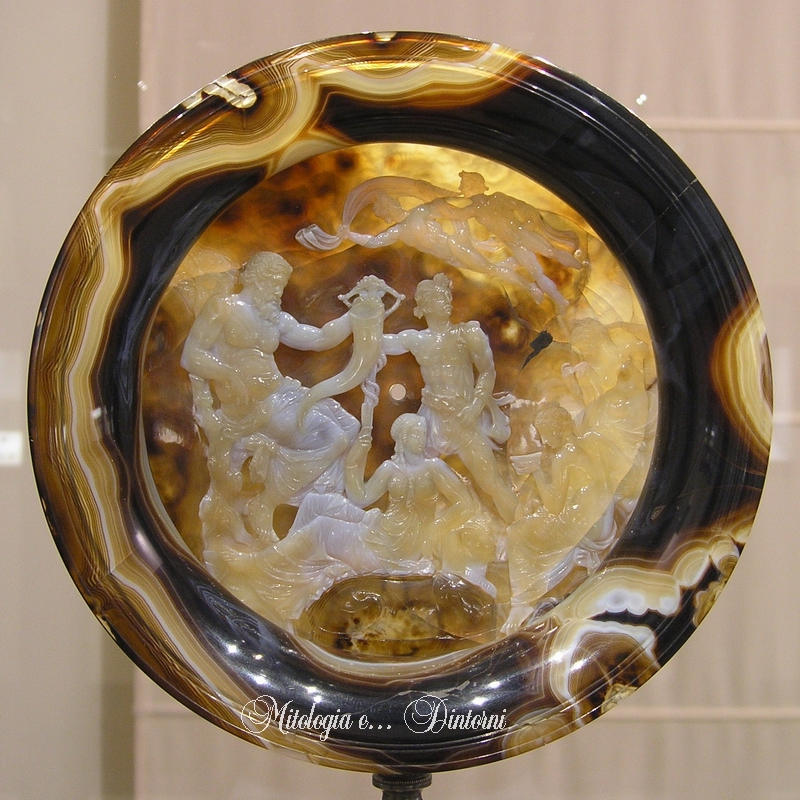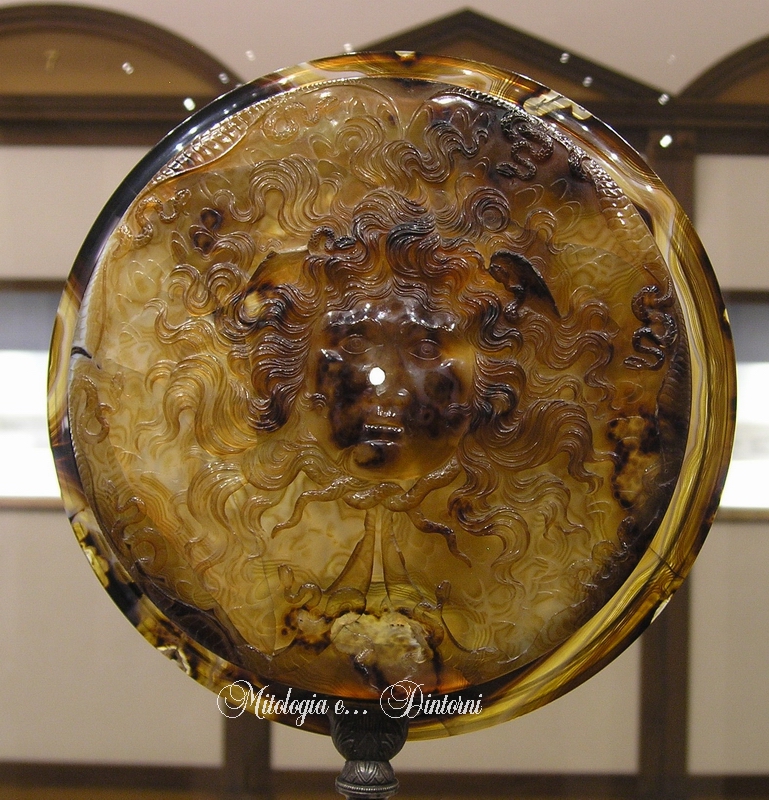LA TAZZA FARNESE

La Tazza Farnese (Inv. 27611) è testimonianza eccezionale della glittica di età ellenistica: unica per dimensioni, livello formale, complessità figurativa e importanza storica.
Incisa in un unico pezzo di agata sardonica a quattro strati e decorata a rilievo su ambedue le facce, ha la forma della phiale, la coppa usata nelle libagioni.
All'interno figure di divinità e personificazioni concorrono a creare una scena dal complesso valore allegorico, suscettibile di livelli interpretativi molteplici, forse non ancora definitivamente chiariti. Al centro, su una Sfinge, simbolo dell'Egitto, siede una figura in abito isiaco, verosimilmente Iside stessa, nella sua assimilazione a Demetra, dea delle messi; a sinistra Ade/Plutone, assimilato a Osiride, con cornucopia; al centro Horus/Trittolemo con il giogo dell'aratro e il sacco delle sementi; a destra due figure femminili, personificazioni delle Stagioni o dei campi coltivati e della rugiada, siedono presso un ciuffo di spighe. Al di sopra si librano in volo due giovani, uno dei quali soffia nella buccina: i venti Etesii, che spirano da nord durante l'estate.
Nella scena interna, chiaramente riconducibile all'ambiente egizio per la presenza della Sfinge e della figura isiaca, è quindi riconoscibile una allegoria della prosperità del regno Tolemaico, alla quale concorrono le maggiori divinità del pantheon egiziano assimilate, secondo modi caratteristici del sincretismo religioso di età ellenistica, alle tre maggiori divinità greche del culto eleusino.
La grande maschera apotropaica di Gorgone raffigurata all'esterno della coppa, allusiva di minaccia ai nemici esterni dello stato, accentua il valore politico della scena interna. In questa si è cercato infatti di riconoscere un riferimento a particolari esponenti della casa regnante egiziana: secondo alcuni interpreti, la triade divina raffigurerebbe Cleopatra III, insieme al marito Tolomeo VIII, morto nel 116 a.C., e al figlio Tolomeo X Alexandros, col quale regge il regno d'Egitto dal 107 a.C.; secondo una più recente teoria la figura di Iside sarebbe un ritratto di Cleopatra VII, ultima regina di Egitto, sconfitta da Ottaviano nel 31 a.C.. La Tazza è stata comunque creata ad Alessandria per essere impiegata, in funzione rituale, nelle fastose cerimonie organizzate dai sovrani d'Egitto, di cui ci informano le fonti letterarie: tipico prodotto di una altissima arte di corte, espressione delle esigenze di rappresentatività dinastica della casa regnante Tolemaica, traduce il messaggio politico in un linguaggio esoterico e volutamente allusivo. L'unicità dell'oggetto, il livello formale elevatissimo dell'incisione, ne rendono ardua una datazione basata su criteri tipologici o stilistici. L'esecuzione della Tazza è pertanto collocata, sulla base di argomenti storici, intorno al 37-34 a.C. o, con maggiori consensi, nel II sec. a.C., eventualmente verso la fine.
Con la conquista del Regno d'Egitto la Tazza, insieme al tesoro Tolemaico, sarà entrata a far parte del tesoro dì stato di Roma; trasferita in seguito a Costantinopoli, è verosimilmente tornata in Occidente dopo la presa di Bisanzio nel 1204. Nel 1239 Federico II di Svevia la acquista da mercanti provenzali; agli inizi del XV secolo è alla corte persiana, a Herat o a Samarcanda; più tardi a Napoli, in proprietà di Alfonso d'Aragona ( + 1458). Nel 1471 si trova a Roma, dove la acquista Lorenzo il Magnifico, in seguito passa, insieme ad alcune gemme, in possesso di Margherita d'Austria e, alla morte di questa, alla famiglia Farnese.

THE FARNESE CUP
The Farnese Cup (Inv. no. 27611) is an exceptional example of Hellenistic glyptics, being unique in size, formal quality, figurative complexity and historical importance.
Carved in a single piece of four-layer sardonyx agate, it is decorated in relief both on the outside and on the inside, and has the shape of a phiale, the cup used in libations. On the inside, figures of divinities and personifications are combined in a scene with complex allegorical meanings, susceptible of multiple interpretative levels and possibly still not completely understood. At the center, sitting on a Sphinx, a symbol of Egypt, is a figure in Isiac attire, presumably Isis herself, assimilated to Demeter, the goddess of the harvest. On the left is Hades/Pluto, assimilated to Osiris, bearing the cornucopia. At the center, again, Horus Triptolemos, bearing the plough yoke and the seed-bag. On the right are two female figures, personifications of the Seasons, or of the cultivated fields and the dew. They are sitting beside a tuft of wheat. Above are two young men lifted in flight, one of whom is blowing in a buccina. They represent the Etesian winds, that blow from the north during the summer.
This scene, clearly referable to Egypt because of the presence of the Sphinx and of the Isiac figure, is recognizable as an allegory of the prosperity enjoyed by the Ptolemaic kingdom under the auspices ot the major deities of the Egyptian pantheon. The latter are assimilated to the three major Greek deities of the Eleusinian cult, according to a religious syncretism typical of the Hellenistic age. The great apotropaic mask of the Gorgon, represented on the outside of the cup, alludes to the threat on the part of external enemies of the state, and reinforces the political value of the scene on the inside. The latter, according to some scholars, may allude to specific members of the Egyptian ruling dynasty. Some scholars think that the divine triad may represent Cleopatra III with her husband Ptolemy VIII, died in 116 BC, and her son Ptolemy X Alexander, with whom she ruled Egypt from 107 BC on, while, according to a more recent theory, the figure of Isis is a portrait of Cleopatra VII, the last queen of Egypt, vanquished by Octavianus in 31 BC. It is certain, in any case, that the cup was made in Alexandria, to be employed in rituals enacted in the course of the lavish ceremonies organized by the kings of Egypt, described in literary sources. It is a typical product of exquisite court art, an expression of the dynastic prestige of the house of the Ptolemies, translating a political message into an esoterical and intentionally allusive language. Because of the unique character of the cup and the exceptional formal quality of its engraving, it is difficult to attempt to date it exclusively on typological or stylistic grounds. Historical evidence, however, indicates that it must have been made either in the period from 37 to 34 BC or, as most scholars believe, in the II century BC, probably towards the end of the century. After the conquest of the kingdom of Egypt, the cup presumably became part, along with the rest of the Ptolemaic treasure, of the Roman state treasure, it was then transferred to Constantinople, and probably returned West after the fall of Byzantium in 1204. In 1239, Frederick II of Swabia bought it from Provencal merchants. At the beginning of the XV century it was at the Persian court, in Herat or Samarcanda. After 1458, it was in Naples. the property of Alfonso of Aragon.
In 1471 it was bought in Rome by Lorenzo the Magnificent. It was later passed on, along with other gems, to Marguerite of Austria and then, at her death, to the Farnese family.
Foto di Giorgio Manusakis per miti3000






